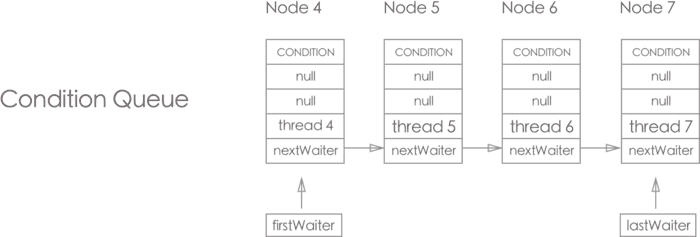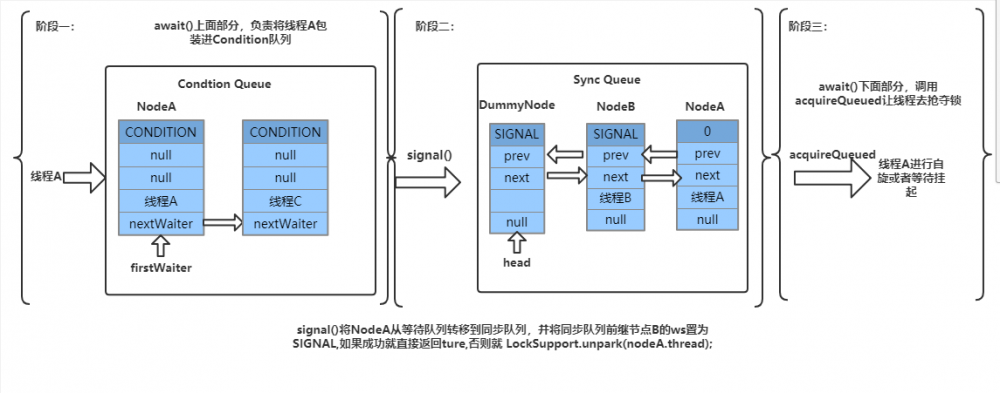JDK并发之独占锁ReentrantLock以及Condition
简介
ReentrantLock是一个可重入且独占式的锁,它具有与使用synchronized监视器锁相同的基本行为和语义,但与synchronized关键字相比,它更灵活、更强大,增加了轮询、超时、中断等高级功能。ReentrantLock,顾名思义,它是支持可重入锁的锁,是一种递归无阻塞的同步机制。除此之外,该锁还支持获取锁时的公平和非公平选择。ReentrantLock是基于AQS的,建议先去看下这篇文章https://juejin.im/post/5cee4e61e51d455c8838e0ec
ReentrantLock的类图如下:

ReentrantLock的内部类Sync继承了AQS,分为公平锁FairSync和非公平锁NonfairSync。如果在绝对时间上,先对锁进行获取的请求你一定先被满足,那么这个锁是公平的,反之,是不公平的。公平锁的获取,也就是等待时间最长的线程最优先获取锁,也可以说锁获取是顺序的。ReentrantLock的公平与否,可以通过它的构造函数来决定。 事实上,公平锁往往没有非公平锁的效率高,但是,并不是任何场景都是以TPS作为唯一指标,公平锁能够减少“饥饿”发生的概率,等待越久的请求越能够得到优先满足。 下面我们着重分析ReentrantLock是如何实现重进入和公平性获取锁的特性
获取锁
ReentrantLock的构造函数为:
public ReentrantLock() {
sync = new NonfairSync();
}
//通过传入一个布尔值来设置公平锁,为true则是公平锁,false则为非公平锁
public ReentrantLock(boolean fair) {
sync = fair ? new FairSync() : new NonfairSync();
}复制代码
公平锁与非公平锁
首先来看内部类Sync对AQS的实现(Sync还有两个子类,分别对应公平和非公平锁实现
abstract static class Sync extends AbstractQueuedSynchronizer {
private static final long serialVersionUID = -5179523762034025860L;
//交给公平和非公平的子类去实现
abstract void lock();
//非公平的排它尝试获取锁实现
final boolean nonfairTryAcquire(int acquires) {
final Thread current = Thread.currentThread();
int c = getState();
//如果AQS的state为0说明获得锁,并且对state加1,其他线程获取锁时被阻塞
if (c == 0) {
if (compareAndSetState(0, acquires)) {
setExclusiveOwnerThread(current);
return true;
}
}
//判断线程是不是重新获取锁,如果是 无需排队,对AQS的state+1处理,这就是重入锁的实现
else if (current == getExclusiveOwnerThread()) {
int nextc = c + acquires;
if (nextc < 0) // overflow
throw new Error("Maximum lock count exceeded");
setState(nextc);
return true;
}
return false;//都不满足获取锁失败,进入AQS队列阻塞
}
//公平的排它尝试释放锁实现
protected final boolean tryRelease(int releases) {
int c = getState() - releases;//对应重入锁而言,在释放锁时对AQS的state字段减1
if (Thread.currentThread() != getExclusiveOwnerThread())
throw new IllegalMonitorStateException();
boolean free = false;
if (c == 0) {//如果AQS的状态字段已变为0,说明该锁被释放
free = true;
setExclusiveOwnerThread(null);
}
setState(c);
return free;
}
//判断是否是当前线程持有锁
protected final boolean isHeldExclusively() {
// While we must in general read state before owner,
// we don't need to do so to check if current thread is owner
return getExclusiveOwnerThread() == Thread.currentThread();
}
//获取条件队列
final ConditionObject newCondition() {
return new ConditionObject();
}
// Methods relayed from outer class
final Thread getOwner() {
return getState() == 0 ? null : getExclusiveOwnerThread();
}
final int getHoldCount() {
return isHeldExclusively() ? getState() : 0;
}
final boolean isLocked() {
return getState() != 0;
}
/**
* 说明ReentrantLock是可序列化的
*/
private void readObject(java.io.ObjectInputStream s)
throws java.io.IOException, ClassNotFoundException {
s.defaultReadObject();
setState(0); // reset to unlocked state
}
}
复制代码
非公平锁
非公平锁实现:
static final class NonfairSync extends Sync {
private static final long serialVersionUID = 7316153563782823691L;
/**
* Performs lock. Try immediate barge, backing up to normal
* acquire on failure.
*/
final void lock() {
//判断当前state是否为0,如果为0直接通过cas修改状态,并获取锁
if (compareAndSetState(0, 1))
setExclusiveOwnerThread(Thread.currentThread());
else
acquire(1);//否则进行排队
}
//调用父类的的非公平尝试获取锁
protected final boolean tryAcquire(int acquires) {
return nonfairTryAcquire(acquires);
}
}
复制代码
非公平锁的实现很简单,在lock获取锁时首先判断判断当前锁是否可以用(AQS的state状态值是否为0),如果是 直接“插队”获取锁,否则进入排队队列,并阻塞当前线程。
公平锁
公平锁实现:
static final class FairSync extends Sync {
private static final long serialVersionUID = -3000897897090466540L;
final void lock() {
acquire(1);//获取公平,每次都需要进入队列排队
}
/**
* 公平锁实现 尝试获取实现方法,
* Fair version of tryAcquire. Don't grant access unless
* recursive call or no waiters or is first.
*/
protected final boolean tryAcquire(int acquires) {
final Thread current = Thread.currentThread();
int c = getState();
if (c == 0) {
//AQS队列为空,或者当前线程是头节点 即可获的锁
if (!hasQueuedPredecessors() &&
compareAndSetState(0, acquires)) {
setExclusiveOwnerThread(current);
return true;
}
}
//重入锁实现
else if (current == getExclusiveOwnerThread()) {
int nextc = c + acquires;
if (nextc < 0)
throw new Error("Maximum lock count exceeded");
setState(nextc);
return true;
}
return false;
}
} 复制代码
可见公平锁和非公平锁区别在于tryAcquire方法中判断条件多了hasQueuedPredecessors()方法 ,该方法定义如下:
public final boolean hasQueuedPredecessors() {
// The correctness of this depends on head being initialized
// before tail and on head.next being accurate if the current
// thread is first in queue.
// 同步队列尾节点
Node t = tail; // Read fields in reverse initialization order
// 同步队列头节点
Node h = head;
Node s;
return h != t &&
((s = h.next) == null || s.thread != Thread.currentThread());
}复制代码
ReentrantLock的获取与释放锁操作都是委托给该同步组件来实现的。
public void lock() {
sync.lock();//根据构造器中的公平锁和非公平锁走不同逻辑
}复制代码
成功获取锁的线程在完成业务逻辑之后,需要调用unlock()来释放锁:
public void unlock() {
sync.release(1);
}
复制代码
unlock()调用 Sync 类的release(int)方法释放锁,release(int)方法是定义在AQS中的方法:
public final boolean release(int arg) {
if (tryRelease(arg)) {
Node h = head;
if (h != null && h.waitStatus != 0)
unparkSuccessor(h);
return true;
}
return false;
}
复制代码
tryRelease(int)是子类需要实现的方法(这是在Sync中实现的方法):
protected final boolean tryRelease(int releases) {
// 计算新的状态值
int c = getState() - releases;
// 判断当前线程是否是持有锁的线程,如果不是的话,抛出异常
if (Thread.currentThread() != getExclusiveOwnerThread())
throw new IllegalMonitorStateException();
boolean free = false;
// 新的状态值是否为0,若为0,则表示该锁已经完全释放了,其他线程可以获取同步状态了
if (c == 0) {
free = true;
setExclusiveOwnerThread(null);
}
// 更新状态值
setState(c);
return free;
}
复制代码
如果该锁被获取n次,那么前(n-1)次tryRelease(int)方法必须返回false,只有同步状态完全释放了,才能返回true。可以看到,该方法将同步状态是否为0作为最终释放的条件,当状态为0时,将占有线程设为null,并返回true,表示释放成功。
Condition Queue
Condition必须被绑定到一个独占锁上使用,在ReentrantLock中,有一个newCondition方法,该方法调用了Sync中的newCondition方法,看下Sync中newCondition的实现:
final ConditionObject newCondition() {
return new ConditionObject();
}
复制代码
ConditionObject是在AQS中定义的,它实现了Condition接口,自然也就实现了上述的Condition接口中的方法。该类有两个重要的变量:
/** First node of condition queue. */ private transient Node firstWaiter; /** Last node of condition queue. */ private transient Node lastWaiter; 复制代码
这里的firstWaiter和lastWaiter是不是和之前说过的head和tail有些类似,而且都是Node类型的。对于Condition来说,它是不与独占模式或共享模式使用相同的队列的,它有自己的队列,所以这两个变量表示了队列的头节点和尾节点。
Condition Queue 是一个并发不安全的, 只用于独占模式的队列(PS: 为什么是并发不安全的呢? 主要是在操作 Condition 时, 线程必需获取 独占的 lock, 所以不需要考虑并发的安全问题); 而当Node存在于 Condition Queue 里面, 则其只有 waitStatus, thread, nextWaiter 有值, 其他的都是null(其中的 waitStatus 只能是 CONDITION, 0 ( 0 代表node进行转移到 Sync Queue里面, 或被中断/timeout ).这里有个注意点, 就是当线程被中断或获取 lock 超时, 则一瞬间 node 会存在于 Condition Queue, Sync Queue 两个队列中

节点 Node4, Node5, Node6, Node7 都是调用 Condition.awaitXX 方法加入 Condition Queue(PS: 加入后会将原来的 lock 释放)。
Condition的关键方法await()
public final void await() throws InterruptedException {
if (Thread.interrupted())
throw new InterruptedException(); //1.如果线程中断抛出InterruptedException
Node node = addConditionWaiter(); //2.调用addConditionWaiter将当前线程如等待队列
int savedState = fullyRelease(node);//3.释放当前线程占用的锁
int interruptMode = 0; //记录在条件队列中中断情况
//4.判断是否在sync队列上,如果节点WaitStatus=CONDTTION或者节点prev为null,那么节点一定
//不再sync队列,如果节点next不为空,那么一定在sync队列上,或者跟sync队列节点逐一比较。
while (!isOnSyncQueue(node)) {
LockSupport.park(this); //5.挂起当前线程
/******************************此处是await()方法的分割线到这里先看signal()方法在回过头看后面代码*/
//此时节点已经被signal()方法加入到同步队列中了,然后调用acquireQueued进行自旋或者挂起等待锁。
//6. 如果等待过程发生中断,中断唤醒发生在signal()之前就throw InterruptedException,
//如果在之后就调用selfInterrupt()标记线程,判断逻辑见下面详解
if ((interruptMode = checkInterruptWhileWaiting(node)) != 0)
break;
}
//7.调用acquireQueued进行自旋或者挂起等待锁.条件1表示同步队列等待过程
//中中断过,条件2是为了兼容2中情况,就是条件队列中断和同步队列中断
if (acquireQueued(node, savedState) && interruptMode != THROW_IE)
interruptMode = REINTERRUPT;
//如果中断超时的话,通过checkInterruptWhileWaiting转移到同步队列的nextWaiter是不为空的
if (node.nextWaiter != null)
unlinkCancelledWaiters();
if (interruptMode != 0)
//9.判断抛出InterruptedException还是调用selfInterrupt()
reportInterruptAfterWait(interruptMode);
}
}
复制代码
await()逻辑:
- 如果当前线程中断,抛出InterruptedException
- 获取当前线程的state数值,然后通过release方法释放state,也就是释放锁。
- 挂起直到对应的signal()方法或者被中断。
- 唤醒后调用acquireQueued()去尝试获取锁,到这步就和线程刚进入同步队列去争夺锁步骤一样了。
- 注意,如果3中的中断唤醒发生在signal()之前就throw InterruptedException,如果在之后就调用selfInterrupt()标记线程中断。
isOnSyncQueue方法
final boolean isOnSyncQueue(Node node) {
//下面2个条件用于快速判断是否在队列中,结合队列转移加入到同步队列过程理解
if (node.waitStatus == Node.CONDITION || node.prev == null)
return false;
if (node.next != null) // If has successor, it must be on queue
return true;
/*
* node.prev can be non-null, but not yet on queue because
* the CAS to place it on queue can fail. So we have to
* traverse from tail to make sure it actually made it. It
* will always be near the tail in calls to this method, and
* unless the CAS failed (which is unlikely), it will be
* there, so we hardly ever traverse much.
*/
return findNodeFromTail(node);
}
复制代码
该方法判断当前线程的node是否在Sync队列中。
- 如果当前线程node的状态是CONDITION或者node.prev为null时说明已经在Condition队列中了,所以返回false;
- 如果node.next不为null,说明在Sync队列中,返回true;
- 如果两个if都未返回时,可以断定 node的prev一定不为null,next一定为null ,这个时候可能node正处于放入Sync队列的执行CAS操作执行过程中。也可能已经转移成功了,通过findNodeFromTail判断
findNodeFromTail方法
private boolean findNodeFromTail(Node node) {
Node t = tail;
for (;;) {
if (t == node)
return true;
if (t == null)
return false;
t = t.prev;
}
}
复制代码
该方法就是从Sync队列尾部开始判断,因为在isOnSyncQueue方法调用该方法时,node.prev一定不为null。但这时的node可能还没有完全添加到Sync队列中,这时可能是在自旋中。见AQS的enq方法,signal的时候会调用这个方法:
private Node enq(final Node node) {
for (;;) {
Node t = tail;
if (t == null) { // Must initialize
if (compareAndSetHead(new Node()))
tail = head;
} else {
node.prev = t;
// 执行findNodeFromTail方法时可能一直在此自旋
if (compareAndSetTail(t, node)) {
t.next = node; // 主要这一步没有执行成功,但是node.prev是不为空的
return t;
}
}
}
}
复制代码
入队列方法 addConditionWaiter
将当前线程封装成一个 Node 节点放入到 Condition Queue 里面大家可以注意到, 下面对 Condition Queue 的操作都没考虑到 并发(Sync Queue 的队列是支持并发操作的), 这是为什么呢? 因为在进行操作 Condition 是当前的线程已经获取了AQS的独占锁, 所以不需要考虑并发的情况。
private Node addConditionWaiter(){
Node t = lastWaiter;
// Condition queue 的尾节点
// 尾节点已经Cancel, 直接进行清除,
/**
* 当Condition进行 awiat 超时或被中断时, Condition里面的节点是没有被删除掉的, 需要其
* 他await 在将线程加入 Condition Queue 时调用addConditionWaiter而进而删除, 或 await
* 操作差不多结束时, 调用 "node.nextWaiter != null" 进行判断而删除 (PS: 通过 signal
* 进行唤醒时 node.nextWaiter 会被置空, 而中断和超时时不会)
*/
if(t != null && t.waitStatus != Node.CONDITION){
/**
* 调用 unlinkCancelledWaiters 对 "waitStatus != Node.CONDITION" 的节点进行
* 删除(在Condition里面的Node的waitStatus 要么是CONDITION(正常), 要么就是 0
* (signal/timeout/interrupt))
*/
unlinkCancelledWaiters();
t = lastWaiter;
}
//将线程封装成 node 准备放入 Condition Queue 里面
Node node = new Node(Thread.currentThread(), Node.CONDITION);
if(t == null){
//Condition Queue 是空的
firstWaiter = node;
} else {
// 追加到 queue 尾部
t.nextWaiter = node;
}
lastWaiter = node;
return node;
}复制代码
fullyRelease方法
final int fullyRelease(Node node) {
boolean failed = true;
try {
int savedState = getState();
if (release(savedState)) { //持有的锁资源全部释放
failed = false;
return savedState;
} else {
throw new IllegalMonitorStateException();
}
} finally {
if (failed)
node.waitStatus = Node.CANCELLED;
}
}
复制代码
ReentrantLock的release方法,该方法在unlock方法中被调用:
public void unlock() {
sync.release(1);
}
复制代码
在unlock时传入的参数是1,因为是可重入的原因,只有在state为0的时候才会真的释放锁,所以在fullyRelease方法中,需要 将之前加入的锁的次数全部释放 ,目的是将该线程从Sync队列中移出。
checkInterruptWhileWaiting方法
private int checkInterruptWhileWaiting(Node node) {
return Thread.interrupted() ?
(transferAfterCancelledWait(node) ? THROW_IE : REINTERRUPT) :
0;
}
复制代码
transferAfterCancelledWait方法
//这是中断超时才会调用的方法
final boolean transferAfterCancelledWait(Node node) {
//如果状态不是-2为0,说明已经转移或者正在转移
//如果还在条件队列中,则修改状态为0加入同步队列
if (compareAndSetWaitStatus(node,Node.CONDITION, 0)) {
enq(node);
return true;
}
/*
* If we lost out to a signal(), then we can't proceed
* until it finishes its enq(). Cancelling during an
* incomplete transfer is both rare and transient, so just
* spin.
*/
while (!isOnSyncQueue(node))
Thread.yield(); //让出执行时间,当前节点正在被其它线程转移到同步队列
return false;
}
复制代码
该方法是判断,在线程中断的时候,是否这时有signal方法的调用。
- 如果compareAndSetWaitStatus(node, Node.CONDITION, 0)执行成功, 则说明中断发生时,没有signal的调用,因为signal方法会将状态设置为0 ;
- 如果第1步执行成功,则将node添加到Sync队列中,并返回true,表示中断在signal之前;
- 如果第1步失败,说明节点正在转移到同步队列中,则检查当前线程的node是否已经在Sync队列中了,如果不在Sync队列中,则让步给其他线程执行,直到当前的node已经被signal方法添加到Sync队列中;
- 返回false
删除Cancelled节点的方法 unlinkCancelledWaiters
当Node在Condition Queue 中, 若状态不是 CONDITION, 则一定是被中断或超时。在调用 addConditionWaiter 将线程放入 Condition Queue 里面时或 awiat 方法获取结束时 进行清理 Condition queue 里面的因 timeout/interrupt 而还存在的节点。这个删除操作比较巧妙, 其中引入了 trail 节点, 可以理解为traverse整个 Condition Queue 时遇到的最后一个有效的节点。
private void unlinkCancelledWaiters(){
Node t = firstWaiter;
Node trail = null;
while(t != null){
Node next = t.nextWaiter; // 1. 先初始化 next 节点
if(t.waitStatus != Node.CONDITION){ // 2. 节点不有效, 在Condition Queue 里面
// Node.waitStatus 只有可能是 CONDITION 或是 0(timeout/interrupt引起的)
t.nextWaiter = null; // 3. Node.nextWaiter 置空
if(trail == null){ // 4. 一次都没有遇到有效的节点
firstWaiter = next;// 5. 将 next 赋值给 firstWaiter(此时 next 可能也是无效的,
// 这只是一个临时处理)
} else {
trail.nextWaiter = next; // 6. next 赋值给 trail.nextWaiter, 这一步其实就是
//删除节点 t
}
if(next == null){ // 7. next == null 说明 已经 traverse 完了
//Condition Queue
lastWaiter = trail;
}
}else{
trail = t; // 8. 将有效节点赋值给 trail
}
t = next;
}
}
复制代码
reportInterruptAfterWait方法
//该方法根据interruptMode来确定是应该抛出InterruptedException还是继续中断。
private void reportInterruptAfterWait(int interruptMode)
throws InterruptedException {
if (interruptMode == THROW_IE)
throw new InterruptedException();
else if (interruptMode == REINTERRUPT)
selfInterrupt();
}
复制代码
Condition的关键方法signal()
public final void signal() {
if (!isHeldExclusively())
throw new IllegalMonitorStateException();
Node first = firstWaiter;
if (first != null)
doSignal(first);
}
//找到第一个waitStatus=CONDITION的节点,将此节点waitStatus=0,入sync队列
//不是CONDITION的节点全部从条件队列中断开连接
private void doSignal(Node first) {
do {
if ( (firstWaiter = first.nextWaiter) == null)
lastWaiter = null;
first.nextWaiter = null;
} while (!transferForSignal(first) &&
(first = firstWaiter) != null);
}
复制代码
转移节点的方法 transferForSignal
transferForSignal只有在节点被正常唤醒才调用的正常转移的方法。 将Node 从Condition Queue 转移到 Sync Queue 里面在调用transferForSignal之前, 会 first.nextWaiter = null;而我们发现若节点是因为 timeout / interrupt 进行转移, 则不会进行这步操作; 两种情况的转移都会把 wautStatus 置为 0 ( 中断或者超时是通过checkInterruptWhileWaiting方法,正常唤醒是通过doSignal方法加入同步队列的 )
final boolean transferForSignal(Node node){
/**
* If cannot change waitStatus, the node has been cancelled
*/
// 1. 若 node 不是CONDITION说明已经被其他线程调用signal()加入到sync队列,或者已经中断,则失败
// 返回false 上层方法会从链表中继续转移下一个
if(!compareAndSetWaitStatus(node, Node.CONDITION, 0)){
return false;
}
// 2. ws成功设置为0则加入 Sync Queue
Node p = enq(node);
int ws = p.waitStatus;
// 3. 这里的 ws > 0 指Sync Queue 中node 的前继节点cancelled 了, 所以, 唤醒一下 node ;
// compareAndSetWaitStatus(p, ws, Node.SIGNAL)失败, 则说明 前继节点已经变成 SIGNAL
//或 cancelled, 所以也要 唤醒
if(ws > 0 || !compareAndSetWaitStatus(p, ws, Node.SIGNAL)){
LockSupport.unpark(node.thread);
}
return true;
}
复制代码
下面画图理解一下:












![[HBLOG]公众号](https://www.liuhaihua.cn/img/qrcode_gzh.jpg)

